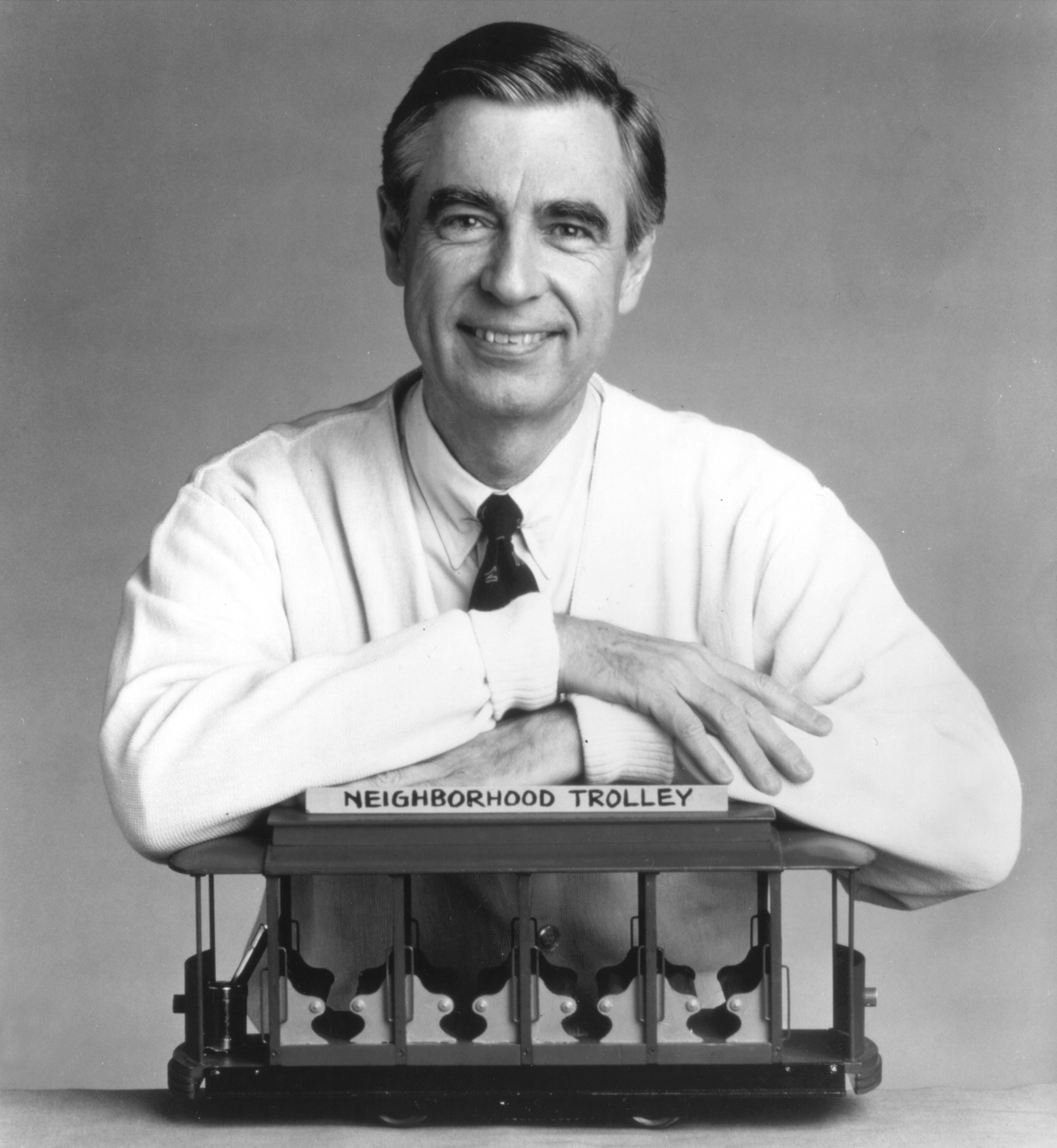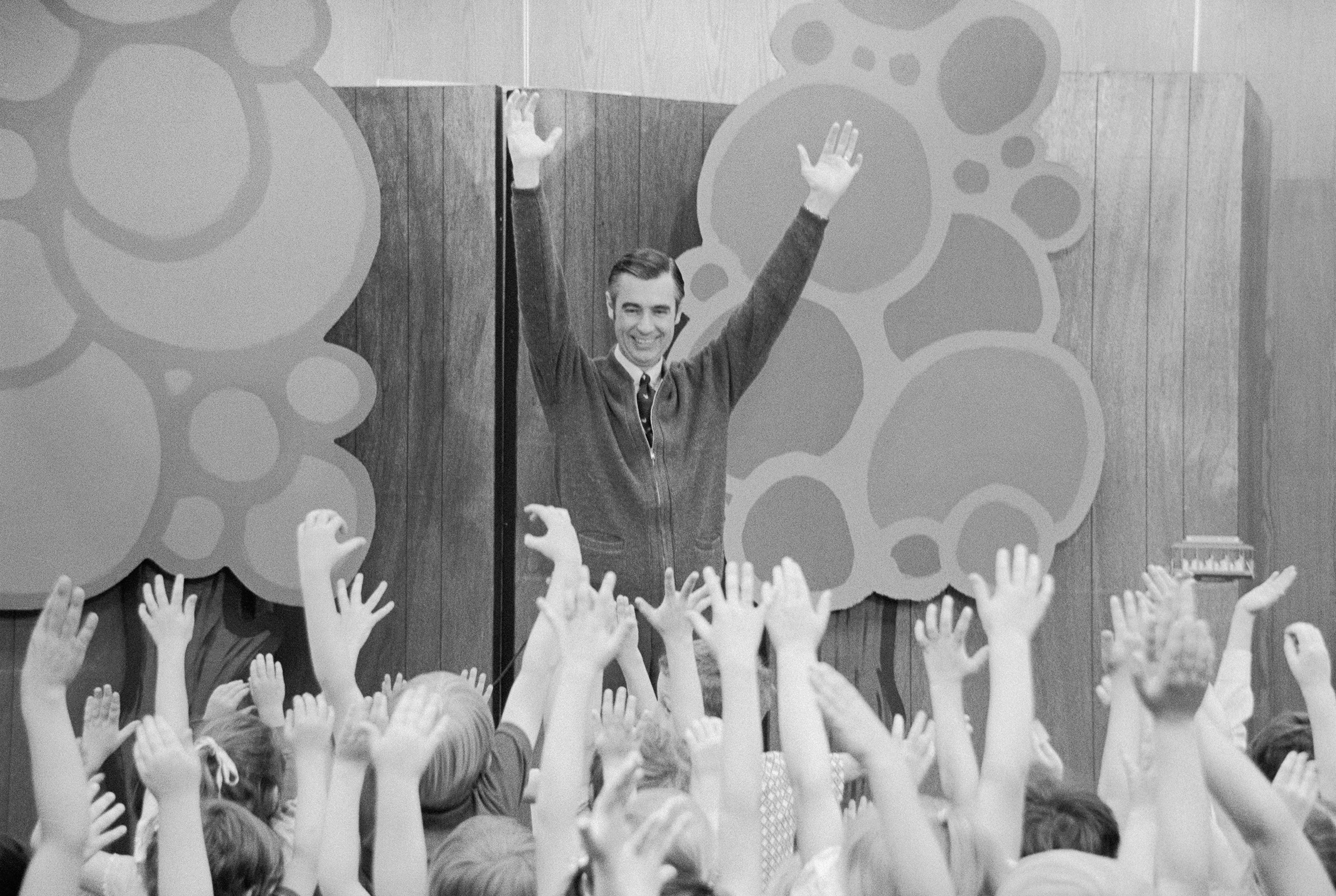
In the early 1970s, if you’d walked through midtown Manhattan at Christmastime, you might have happened upon Hallmark’s flagship store. The flashy displays would have stretched out before you, each designed by different celebrities to promote their various products. And one display in particular would likely have caught your eye, if only for its simplicity.
A small pine tree, shorn of lights and ornamentation and about the height of a child, stood encased in clear acrylic so its roots would show in the soil. There was no product to hawk, no photograph to admire, no movie-star name in lights. In fact, the only clue as to who had designed it had to be deduced — in this case, from a plaque containing a single declarative sentence: “I like you just the way you are.”
Perhaps the only thing more surprising than this understated message was that its creator, Fred Rogers, had worked with Hallmark at all. Throughout his career, the host of Mister Rogers’ Neighborhood had railed against consumerism, refusing to license his image even to lucrative giants like Burger King.
But Rogers also knew what holidays could do. During a primetime Neighborhood Christmas special, he focused not on gifts or even the birth of Christ, but on the importance of community. “I suppose the thing I’d like most to be able to give you is hope,” he told viewers. On holidays like Christmas, “I hope you’ll be able to look for all the different ways that people have of showing that they love you.”
After a year marked by misery and loss and alienation and despair, it’s a hope that’s never been more urgent. That’s why we’re calling for a new national holiday, one designed to bring more Mister Rogers into our civic lives.
It’s called 143 Day.
First established two years ago in his native Pennsylvania, the holiday takes its name from Rogers’ favorite number. 143 was his code for “I love you,” a numerical shorthand derived from the number of letters that comprise each word. He used the number in the Neighborhood and even in real life, where he maintained his 143-pound body weight for decades.
Occurring on the 143rd day of the year, May 23 marks a statewide call to live up to Rogers’ ideal. “Imagine what our real neighborhoods would be like if each of us offered, as a matter of course, just one kind word to another person,” he once mused. That word could take many forms, from a friendly hello to a neighborhood cleanup to a home-cooked meal for a neighbor who’s hungry. As Rogers liked to remind us, there are many ways to say I love you.
Making 143 Day national would do more than foster nice feelings. As we detail in our new book, When You Wonder, You’re Learning: Mister Rogers’ Enduring Lessons for Raising Creative, Curious, Caring Kids, Rogers relied on top pediatricians, psychologists, educators, and actors to help him build his Neighborhood. Everything he did was grounded in science, and the holiday named for his number is no exception.
Studies from around the world have correlated community-centric holidays like Christmas with reduced rates of self-harm and suicide. Though the effects are temporary, they’re also significant. Even Congress, a body that’s long been ambivalent and even hostile toward new holidays, has recognized the “substantial benefits to both the spiritual and economic life of the nation” that national holidays provide.
It’s safe to say we need those benefits now. Shutdowns, job losses, and social withdrawal — not to mention hundreds of thousands of lonely, often preventable deaths — have accelerated trends that predate the pandemic. Even before COVID-19, only about half of Americans knew some of their neighbors. Many of us were more likely to scroll through NextDoor than to actually go next door, viewing our neighbors through belligerent lens of an algorithm. Not surprisingly, a 2016 survey found that less than a third of Americans think most people can be trusted, with young people far and away the most suspicious of others. Enthusiasm for democracy has likewise waned, and we don’t have to imagine where all this might lead us.
Would 143 Day fix these problems? Of course not. But the holiday might, at the very least, nudge us in hope’s direction.

According to data from the Pew Research Center, nearly 90 percent of Americans think it’s possible to improve our confidence in one another. Their prescription, it turns out, is a simple one: neighborliness. As one young woman told pollsters, “Get to know your local community. Take small steps towards improving daily life, even if it’s just a trash pick-up. If people feel engaged with their environment and with each other, and they can work together even in a small way, I think that builds a foundation for working together on more weighty issues.”
Science and history suggest she’s right. Writing for The Atlantic, journalist Anne Applebaum notes that in conflict zones around the world — in “countries where political opponents have seen each other as not just wrong, but evil” — residents have repaired their social fabric by building community centers and organizing jobs programs. “The literature in the fields of peacebuilding and conflict prevention overflows with words such as local and community-based and economic regeneration,” Applebaum writes. “It’s built on the idea that people should do something constructive — something that benefits everybody, lessens inequality, and makes people work alongside people they hate. That doesn’t mean they will then get to like one another, just that they are less likely to kill one another on the following day.” It’s a start.
By creating a designated holiday for community projects, 143 Day would also set a new example for young people. “Social research has gathered impressive evidence to show that when people work together for group goals, there are a number of desirable effects on people’s feelings for one another,” write Rachel Lotan and the late Elizabeth Cohen, two Stanford University education professors whose book, Designing Groupwork, calls for deploying cooperative projects in classrooms.
Skeptics might wonder why such aims require a holiday. People can and do act neighborly every day of the year, and other holidays already include a service component. National holidays are also notoriously difficult to establish: Our “newest” holiday, Martin Luther King Jr. Day, was formalized in 1983 after 15 years of activism, Congressional stalling, and a song by Stevie Wonder. The push for Juneteenth has encountered similar resistance.
So why bother with 143 Day? Why not settle for something less “official” but no less admirable, like Earth Day?
The simple answer is that the best way to encourage community involvement is to give people the time to do it. A lack of time, whether real or perceived, has enormous effects on human behavior: It’s one of the top reasons that so many people don’t vote, even when doing so could improve their communities. (And it’s why so many others want to make Election Day — you guessed it — a national holiday.) When our daily pressures threaten to crush us, we’re far less likely to indulge our neighborly instincts, even when the need is urgent and plain.
At about the same time Rogers was crafting his Hallmark display, two behavioral scientists concocted an experiment. John Darley and Daniel Batson asked a few dozen seminary students to record a sermon on the Good Samaritan — the Biblical story in which a man, beaten and robbed, is left for dead on the side of the road and ignored by potential helpers. Some of the students were told they could take their time getting to the recording room; others were told they were late and should hurry as fast as they could. Along the way, each student passed a “victim” — an actor found slumped in a doorway, coughing and groaning. Among the students who’d been told they had plenty of time, 63 percent offered the victim assistance. But among those who’d been told to hurry, just 10 percent bothered to stop.
A few decades later, psychologist Sara Konrath and her colleagues found that empathy levels among college students had fallen by about 40 percent between 1979 and 2009. Though they stopped short of pinpointing a cause, the researchers speculated that media saturation and relentless pressure to achieve were among the likely culprits. Digital-age young people aren’t inherently less empathetic, but they are more anxious and busy and stressed out and scared, and it’s hard to walk in your neighbor’s shoes when that’s the way you feel.
Rogers himself understood this, waking each morning at 5 a.m. to give himself a few free hours. “He would read the Bible, pray for other people, and then he would think about the coming day,” explains his biographer, Maxwell King. “He would spend that time envisioning who he was going to see and how he would be fully engaged and thoughtful and considerate and kind with whomever he encountered.”
Making 143 Day national would give us the space to do the same. It might seem out of place on our busy modern calendars — a day shorn, like Rogers’ Hallmark tree, of artifice and pomp. A day to show ourselves, through selfless, small-scale acts, that each of us is enough; that our humanity alone makes us worthy of the neighborhood. A day not to accept every neighbor’s views, or to abandon accountability, or to sacrifice justice at the altar of being kind, but instead to do the most difficult work there is: loving thy neighbor exactly as they are.
More Must-Reads from TIME
- Cybersecurity Experts Are Sounding the Alarm on DOGE
- Meet the 2025 Women of the Year
- The Harsh Truth About Disability Inclusion
- Why Do More Young Adults Have Cancer?
- Colman Domingo Leads With Radical Love
- How to Get Better at Doing Things Alone
- Michelle Zauner Stares Down the Darkness
Contact us at letters@time.com